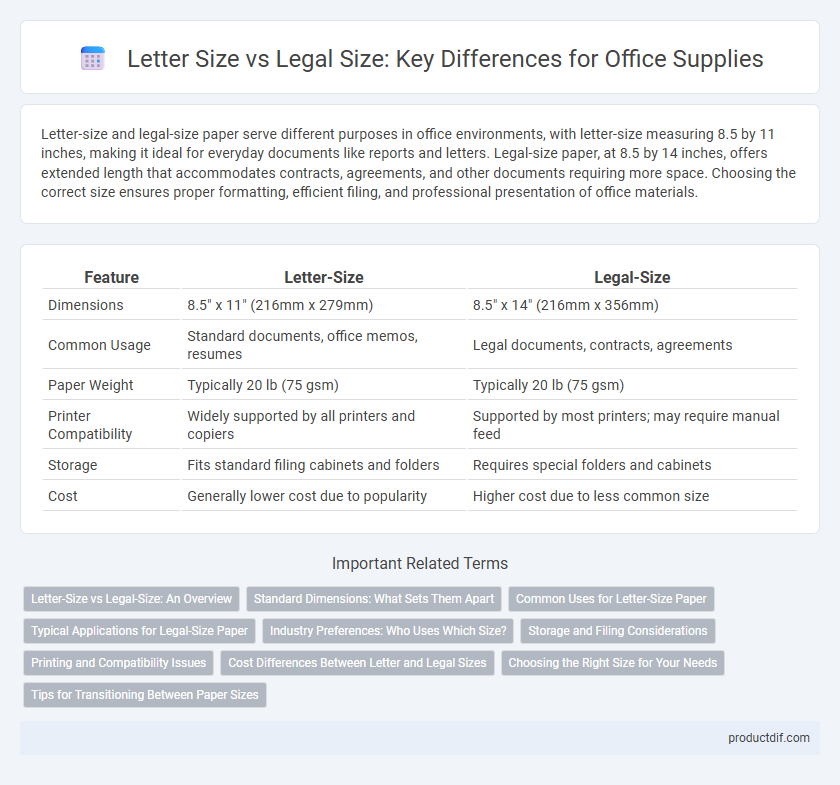Letter-size and legal-size paper serve different purposes in office environments, with letter-size measuring 8.5 by 11 inches, making it ideal for everyday documents like reports and letters. Legal-size paper, at 8.5 by 14 inches, offers extended length that accommodates contracts, agreements, and other documents requiring more space. Choosing the correct size ensures proper formatting, efficient filing, and professional presentation of office materials.
Table of Comparison
| Feature | Letter-Size | Legal-Size |
|---|---|---|
| Dimensions | 8.5" x 11" (216mm x 279mm) | 8.5" x 14" (216mm x 356mm) |
| Common Usage | Standard documents, office memos, resumes | Legal documents, contracts, agreements |
| Paper Weight | Typically 20 lb (75 gsm) | Typically 20 lb (75 gsm) |
| Printer Compatibility | Widely supported by all printers and copiers | Supported by most printers; may require manual feed |
| Storage | Fits standard filing cabinets and folders | Requires special folders and cabinets |
| Cost | Generally lower cost due to popularity | Higher cost due to less common size |
Letter-Size vs Legal-Size: An Overview
Letter-size paper measures 8.5 x 11 inches, commonly used for everyday printing and standard office documents. Legal-size paper, at 8.5 x 14 inches, suits contracts and legal documents requiring extra length. Choosing between letter-size and legal-size depends on specific printing needs and document formatting requirements.
Standard Dimensions: What Sets Them Apart
Letter-size paper measures 8.5 x 11 inches, making it the standard choice for everyday documents and printing in the United States. Legal-size paper, at 8.5 x 14 inches, offers extended length for contracts, agreements, and legal documents requiring more space. The difference in dimensions primarily affects document formatting, filing systems, and printer compatibility for office supplies.
Common Uses for Letter-Size Paper
Letter-size paper, measuring 8.5 by 11 inches, is commonly used for everyday office documents such as letters, memos, and reports due to its compatibility with standard printers and copiers. It is preferred for creating professional correspondence, school assignments, and official forms that require easy handling and filing. This paper size supports efficient document management in offices by fitting standard folders, filing cabinets, and envelopes.
Typical Applications for Legal-Size Paper
Legal-size paper, measuring 8.5 x 14 inches, is predominantly used in legal, real estate, and government documents due to its extended length accommodating lengthy contracts, agreements, and forms. Its extra space allows for detailed content, making it ideal for reports, invoices, and records that require additional lines or detailed annotations. Businesses often choose legal-size paper for official documents where clarity and comprehensiveness are essential.
Industry Preferences: Who Uses Which Size?
Legal-size paper, measuring 8.5 x 14 inches, is predominantly favored by legal firms, government agencies, and accounting offices due to its extended length accommodating detailed contracts and financial documents. Letter-size paper, standardized at 8.5 x 11 inches, is widely used across corporate environments, educational institutions, and general office settings for everyday printing and correspondence. The choice between letter-size and legal-size paper often hinges on industry-specific document requirements, influencing purchasing decisions in office supply procurement.
Storage and Filing Considerations
Letter-size paper measures 8.5 by 11 inches and fits standard filing cabinets and folders, optimizing storage space in typical office environments. Legal-size paper, at 8.5 by 14 inches, requires larger files and specialized storage solutions, often reducing filing efficiency. Choosing letter-size paper streamlines storage and filing processes by maximizing the use of standard office equipment dimensions.
Printing and Compatibility Issues
Letter-size paper (8.5 x 11 inches) is the standard format for most printers, ensuring seamless compatibility and optimal print quality. Legal-size paper (8.5 x 14 inches) can cause printing issues such as paper jams or misalignment if the printer does not support extended lengths. Verifying printer specifications for paper size compatibility is essential to avoid workflow interruptions and maintain professional document presentation.
Cost Differences Between Letter and Legal Sizes
Letter-size paper (8.5 x 11 inches) typically costs less per ream compared to legal-size paper (8.5 x 14 inches) due to its widespread use and higher production volume. Legal-size paper often incurs higher expenses not only in purchase price but also in storage and handling because of its larger dimensions. Businesses choosing between the two sizes must factor in these cost differences alongside their specific printing and documentation needs.
Choosing the Right Size for Your Needs
Letter-size paper measures 8.5 x 11 inches, making it ideal for everyday printing, standard documents, and office correspondence, while legal-size paper, at 8.5 x 14 inches, offers extra length for contracts, legal forms, and detailed reports. Choosing the right size depends on document type, printer compatibility, and filing requirements to ensure professional presentation and efficient storage. Consider the purpose and typical content of your documents to optimize workflow and avoid resizing or reformatting issues.
Tips for Transitioning Between Paper Sizes
When transitioning between letter-size (8.5" x 11") and legal-size (8.5" x 14") paper, adjust your printer settings to accommodate the longer length of legal paper to avoid misfeeds or jams. Use adjustable paper trays and guides in your copier or printer to ensure proper alignment and smooth feeding during printing tasks. Keep stacks of both sizes organized separately to quickly identify the correct paper, reducing confusion and streamlining workflow in your office environment.
Letter-size vs Legal-size Infographic

 productdif.com
productdif.com